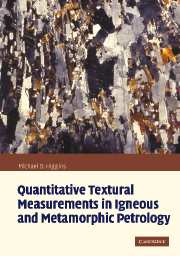Book contents
- Frontmatter
- Contents
- Acknowledgements
- 1 Introduction
- 2 General analytical methods
- 3 Grain and crystal sizes
- 4 Grain shape
- 5 Grain orientations: rock fabric
- 6 Grain spatial distributions and relations
- 7 Textures of fluid-filled pores
- 8 Appendix: Computer programs for use in quantitative textural analysis (freeware, shareware and commercial)
- References
- Index
6 - Grain spatial distributions and relations
Published online by Cambridge University Press: 08 August 2009
- Frontmatter
- Contents
- Acknowledgements
- 1 Introduction
- 2 General analytical methods
- 3 Grain and crystal sizes
- 4 Grain shape
- 5 Grain orientations: rock fabric
- 6 Grain spatial distributions and relations
- 7 Textures of fluid-filled pores
- 8 Appendix: Computer programs for use in quantitative textural analysis (freeware, shareware and commercial)
- References
- Index
Summary
Introduction
Grains in many rocks are not distributed randomly in space, but organised into clusters, layers and chains (Figure 6.1). Such spatial patterns can be defined in a number of ways: by the presence of grains as well as by their size, shape, orientation and mineral associations. Such non-random distributions of grains, termed patterns or packings, have been observed in metamorphic, igneous and sedimentary rocks (Rogers et al., 1994, Jerram et al., 2003). Despite the fact that quantitative investigation of such structures in a rock was started in 1966 (Kretz, 1966a), there have been relatively few quantitative studies since that time. Many terms have been used to describe nonuniform grain distributions: in igneous rocks grain clusters are referred to as clumps, clots or glomerocrysts, whereas in metamorphic petrology other textural terms are used. Another important textural aspect of a rock is the spatial association of minerals, or lack thereof. This may reflect nucleation, growth or mineral breakdown processes, but has been much less studied than the actual crystal positions.
Patterns can be imposed on a rock during its formation by externally varying conditions or can develop spontaneously. For instance, during deposition of sediments variations in the flow regime or sediment source can produce layers; these are clearly imposed externally. Some layering in igneous rocks may result from similar sedimentary processes (Naslund & McBirney, 1996). Layering in metamorphic rocks can reflect layering of a sedimentary protolith, and deformation of dykes and enclaves.
- Type
- Chapter
- Information
- Publisher: Cambridge University PressPrint publication year: 2006



